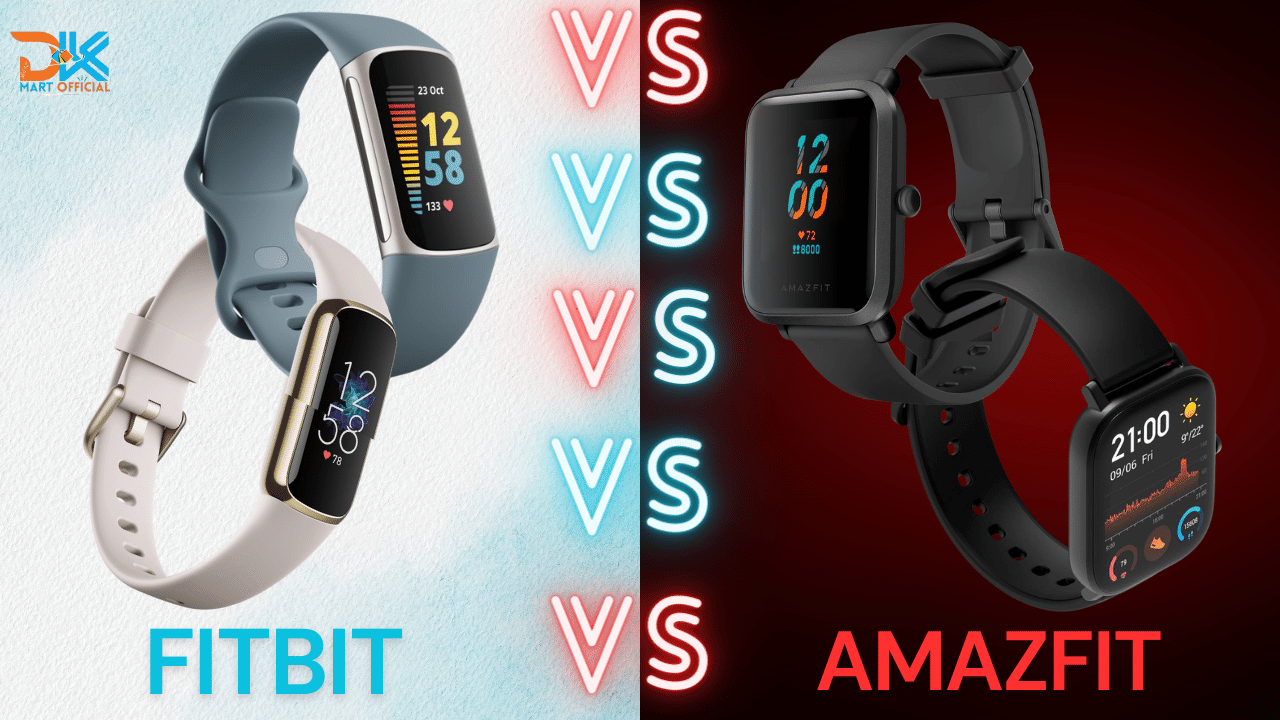Fitbit vs Amazfit: Decoding the Fitness Tracker Face-Off
Fitbit, a pioneer in wellness technology, has left an indelible mark by stressing simplicity and precision in its activity trackers. Fitbit has a rich history spanning more than a decade, and its solutions have evolved to meet consumers’ shifting needs. The brand’s commitment to seamless integration into daily life is seen in its diverse selection of gadgets, each tailored to a certain preference. Fitbit does more than just track physical activity; it also promotes a sense of community through its huge app. Challenges, individualized goals, and real-time feedback drive users to take a holistic approach to their health and well-being. As we go deeper into the Fitbit world, its past provides an impressive backdrop for comparison with the new challenger
Amazfit, backed by Huami’s technological strength, emerges as a new-age maverick in the fitness tech space. This brand upsets the market by perfectly mixing style and substance, providing people with an appealing alternative. Amazfit’s portfolio, which features elegant designs and innovative sensing technology, demonstrates a commitment to pushing the boundaries of innovation. The brand’s competitive advantage stems not just from its technological skills, but also from its strategic pricing, which makes cutting-edge fitness tracking affordable to a wider audience. As we begin the Fitbit vs Amazfit comparison, Amazfit’s role as a disruptor provides an engaging story about how it breaks established standards by providing consumers with more than just a fitness tracker but also a lifestyle partner.
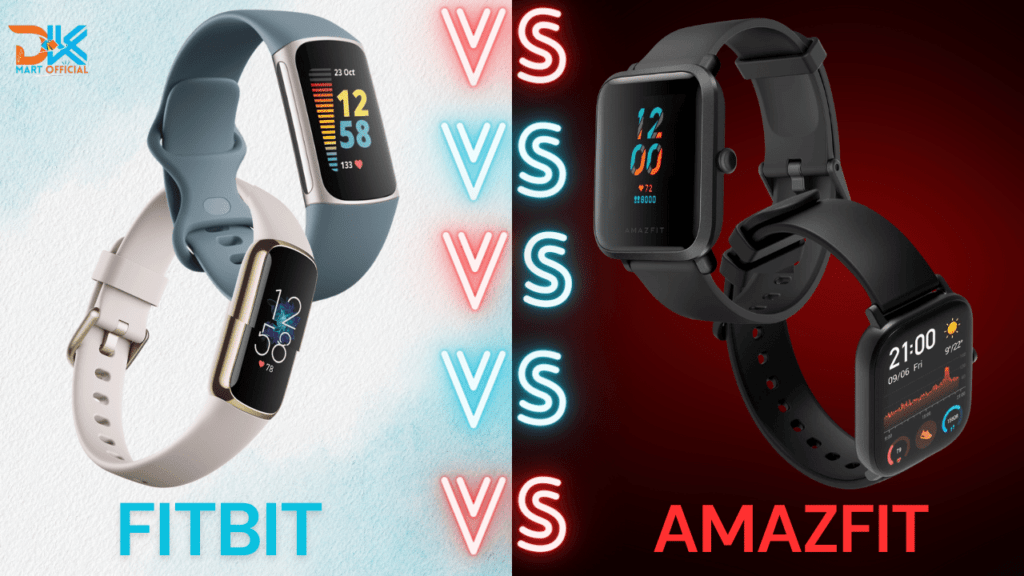
Fitbit vs Amazfit: Design and Display
Fitbit vs Amazfit: Fitbit, known for its sleek and minimalist design aesthetic, creates fitness trackers that flow easily into daily life. The brand focuses on comfort and wearability, guaranteeing that users may easily wear their gadgets throughout the day. Fitbit’s visual appeal stems from its simplicity, with a focus on clean lines and a selection of interchangeable bands that allow customers to customize their appearance. The brand’s commitment to user-friendly design extends to its devices’ easy navigation, which provides a hassle-free experience for consumers of all ages.
Fitbit uses cutting-edge display technologies to improve user interaction. While particular features may differ between models, Fitbit frequently incorporates bright touchscreens that allow crisp and clear vision in varied lighting conditions. The screens effectively communicate critical information, ranging from daily activity statistics to upcoming notifications. Fitbit’s emphasis on a user-friendly interface makes accessing and analyzing data a seamless experience, which adds to the overall appeal of the design and display.
Amazfit, which falls under the Huami umbrella, takes a more diverse design approach. The brand offers fitness trackers in a variety of styles, from athletic and rugged to sleek and tech-savvy. Amazfit’s commitment to innovation is demonstrated by its research of materials, textures, and form factors, which provides users with a greater range of options. Amazfit’s design language aims to cater to a wide range of interests, whether they prefer a fitness-focused look or a more casual, everyday style.
Amazfit devices frequently use advanced display technology, including AMOLED panels in some versions. This technique improves color brightness and contrast, resulting in an immersive visual experience. The use of high-quality materials and robust glass enhances the overall sophistication of Amazfit’s display options. The brand’s focus on producing a visually appealing interface is consistent with its tech-forward design philosophy, giving users both beauty and substance in their fitness trackers.
In the design and display battle between Fitbit and Amazfit, customers will find themselves at the crossroads of Fitbit’s minimalist elegance and Amazfit’s diverse design palette, each catering to different tastes and preferences. The choice between the two ultimately comes down to whether people prefer a classic, user-friendly appearance or a more diverse and technologically advanced design approach.
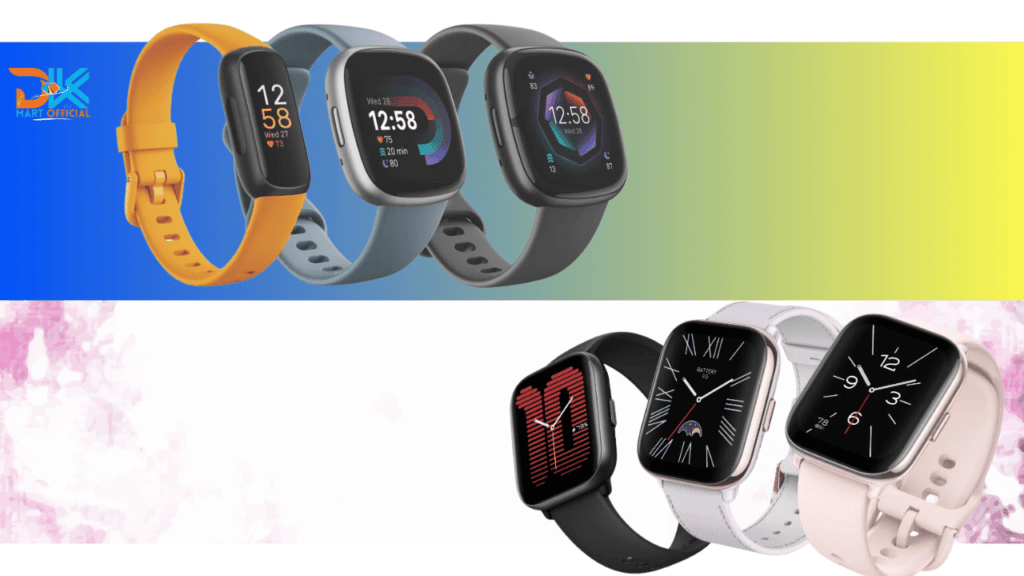
Fitbit vs Amazfit: Fitness and Health Tracking
Fitbit vs Amazfit: Fitbit is a stalwart in the fitness monitoring industry, known for providing customers with accurate and comprehensive stats. The brand’s devices capture daily activity seamlessly through step counting, accurately measure heart rates, and provide extensive insights into sleep habits. Fitbit’s commitment to user health goes beyond the fundamentals, with features like SpO2 monitoring for blood oxygen levels and stress tracking for overall wellness. GPS incorporation in select models improves distance tracking accuracy for outdoor activities. Fitbit’s software ecosystem supplements its hardware prowess by offering a user-friendly interface that promotes goal-oriented progress and builds a sense of camaraderie among people aiming for healthier living.
Amazfit, which operates under Huami’s technology umbrella, has established itself as a powerful contender in the fitness tracking market. Amazfit devices include a comprehensive array of sensors that not only measure typical metrics such as steps and heart rate but also provide sophisticated health insights. Sleep tracking is still a major function, and the addition of heart rate variability (HRV) data and a PAI (Personal Activity Intelligence) score improves the amount of health tracking available. Amazfit’s drive for innovation is obvious in its pursuit of specialized measures, which provide customers with nuanced data to gain a better knowledge of their overall health.
As people traverse the Fitbit vs Amazfit choice, the selection depends on the level of health insights required, whether it is Fitbit’s established accuracy or Amazfit’s.

Fitbit vs Amazfit: Battery Life and Connectivity
Fitbit vs Amazfit: Fitbit has carved out a name for itself by mastering the art of battery efficiency in the competitive world of fitness trackers. The brand’s commitment to long-lasting battery life is a noteworthy feature, with several Fitbit models lasting a full week on one charge. This endurance not only meets consumers’ practical demands but also demonstrates Fitbit’s commitment to offering a consistent and dependable tracking experience. Aside from its battery power, Fitbit provides smooth connectivity via Bluetooth technology.
This feature enables customers to seamlessly sync their Fitbit devices with smartphones, receiving real-time notifications and ensuring that fitness data is easily accessible via the user-friendly Fitbit app. Fitbit’s focus on both prolonged battery life and excellent connectivity puts its gadgets as reliable companions for persons navigating their wellness journeys.
Amazfit, a worthy contender in the fitness tracker industry, shares Fitbit’s commitment to long-lasting battery performance. With models that may last many days on a single charge, Amazfit meets the demand for regular tracking without the hassle of frequent recharge. This lifespan is especially useful for individuals who have active lifestyles. Amazfit’s connectivity capabilities add to its attractiveness, including wireless connectivity for smooth syncing with smartphones and connected devices. This integration ensures that customers have access to current health and fitness metrics on both their Amazfit device and the accompanying app.
As users explore the Fitbit vs Amazfit options, the choice between Fitbit’s established battery lifetime and smooth connectivity and Amazfit’s enduring performance and current wireless features comes down to personal tastes and lifestyle factors.
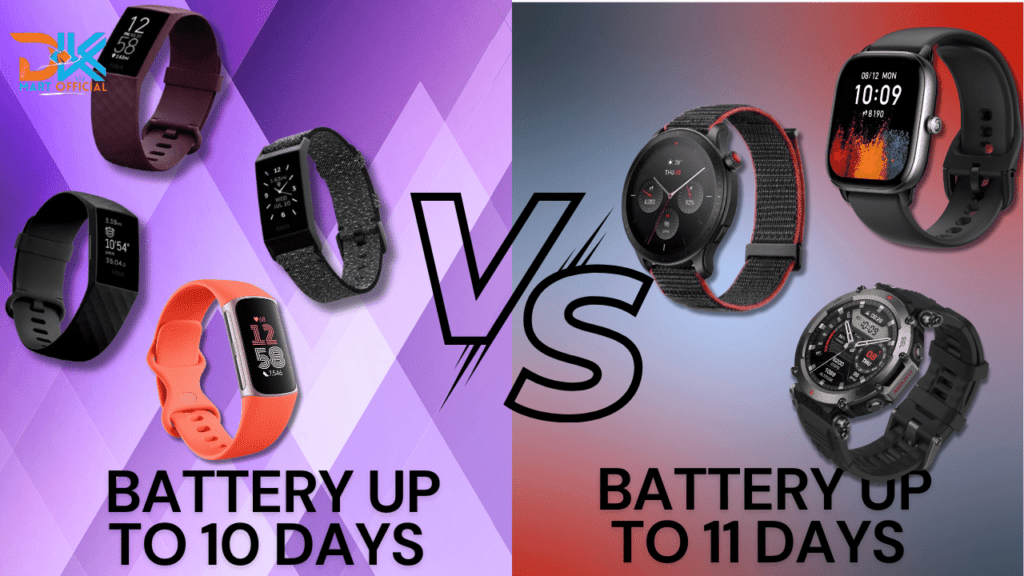
Fitbit vs Amazfit: App Ecosystem and Compatibility
Fitbit has positioned itself as more than simply a fitness tracker manufacturer; it is also the curator of a robust app ecosystem. The Fitbit app functions as a central point for users to precisely examine their fitness and health data. It has an easy-to-use interface that provides information about steps taken, sleep quality, heart rate patterns, and other factors. Fitbit’s software extends beyond individual tracking to build a sense of community through challenges and goal-sharing features. The app is cross-platform compatible, making it accessible to a wide range of users. Fitbit’s focus to software development matches its technology, resulting in a more connected ecosystem that improves the whole fitness monitoring experience.
Amazfit, supported by Huami, has been progressively improving its app ecosystem to complement its varied line of fitness trackers. The Zepp app, when used in conjunction with Amazfit devices, provides a platform for users to monitor and analyze their health and fitness data. Amazfit’s app, like Fitbit’s, provides insights into step counts, sleep habits, and heart rate data. The app’s layout is user-friendly, allowing for simple navigation and data interpretation. Amazfit’s app compatibility spans both Android and iOS platforms, catering to a diverse user base. While Amazfit’s app ecosystem is not as developed as Fitbit’s, its frequent updates and commitment to improvement represent a brand that adapts to meet the requirements of its users.
In the Fitbit vs Amazfit app ecosystem and compatibility comparison, consumers must choose between Fitbit’s well-established, community-focused platform and Amazfit’s emerging but promising app. Individual tastes, the relevance of community interaction, and the desire for a mature vs expanding app ecosystem all play a role in the final decision.
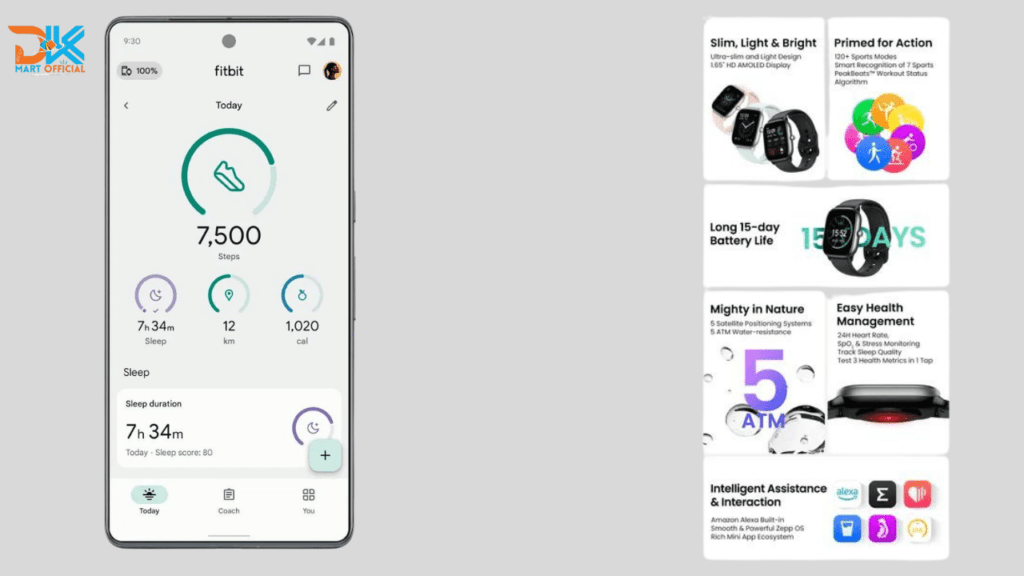
Fitbit vs Amazfit: Price Range and Value for Money
Fitbit, a well-known name in the fitness tracker industry, portrays itself as a premium brand with gadgets that reflect precision, style, and a broad feature set. While Fitbit devices are more expensive, users who invest in the brand benefit from a sophisticated ecosystem, precise health tracking, and a plethora of advanced features. Fitbit’s premium reputation is highlighted by its focus to providing a whole wellness experience, making it an excellent choice for consumers who value cutting-edge technology and are ready to invest in a high-quality fitness companion.
In terms of pricing and innovation, Amazfit stands out as a dynamic player, providing feature-rich fitness trackers at low prices. Amazfit, powered by Huami’s technological expertise, provides AMOLED screens, built-in GPS, and specific health indicators to a more cost-conscious audience. The brand’s dedication to providing good value for money is obvious in its wide product line, which allows users to access advanced capabilities without breaking the bank. Amazfit’s distinctive proposition is to strike a balance between price and innovation, making it an intriguing option for those looking for a low-cost but technologically advanced fitness tracking solution.
The Fitbit vs Amazfit comparison develops as a detailed examination of personal preferences and financial constraints. Fitbit’s luxury allure appeals to those seeking a refined and feature-rich experience, whilst Amazfit’s cost-effective innovation allows a broader audience to adopt advanced fitness monitoring without sacrificing crucial functionalities. Finally, users can select between Fitbit’s established quality and Amazfit’s innovative cost based on their own objectives in the fitness tracker space.
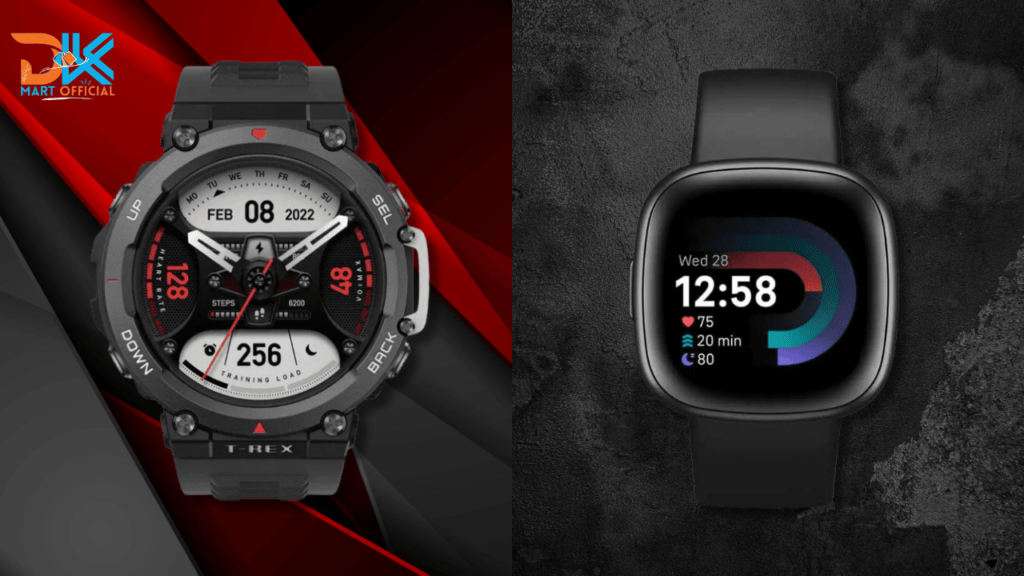
Fitbit vs Amazfit: Heart Rate Monitoring
Fitbit, a fitness tracking pioneer, has mastered the art of heart rate monitoring, giving not only accuracy but also a seamless integration of hardware and user information. Fitbit’s devices use precision-engineered sensors that work together to collect continuous heart rate information. The brand’s dedication to accuracy extends to dynamic tracking during varied activities, guaranteeing that customers receive accurate readings at both rest and exertion. Fitbit’s approach gives consumers both real-time heart rate data and a framework for in-depth studies, encouraging a comprehensive awareness of cardiovascular health. Fitbit’s heart rate monitoring demonstrates its commitment to the delicate convergence of technology and user well-being.
Amazfit, which operates under Huami’s technical umbrella, directs a symphony of heart health measurements via its powerful BioTracker. This sensor, which is built into many Amazfit devices, elevates heart rate monitoring to an art form. Beyond conventional tracking, the BioTracker includes heart rate variability (HRV) data, which provide a deeper layer of physiological understanding. HRV data not only provides a comprehensive view of stress levels, but it also helps to deepen our understanding of general heart health. Amazfit’s BioTracker exemplifies the company’s commitment to pushing technological frontiers, providing consumers with a symphony of heart health indicators for a more complete workout experience.
In the Fitbit vs Amazfit heart rate monitoring comparison, users are faced with a choice between dependability and innovation. Fitbit’s seamless harmony ensures precise and continuous tracking, whilst Amazfit’s BioTracker introduces a symphony of measurements, deepening the cardiovascular narrative. The difference between Fitbit and Amazfit is based on the desire for exact statistics vs a technologically enhanced heart health experience, catering to those desiring a traditional or more advanced approach to fitness tracking.

Fitbit vs Amazfit: Sleep Tracking
Fitbit has long been a leader in sleep tracking, providing customers with detailed information about their nightly sleep. Fitbit devices use advanced sensors to track sleep duration, stages (light, deep, REM), and interruptions. The brand’s Sleep Score condenses this information into a single number, giving users a rapid overview of their sleep quality. Fitbit’s commitment to sleep health is seen in features such as Sleep Insights, which provides individualized advice to improve sleep quality based on individual patterns. Fitbit’s ability to track both short-term and long-term sleep trends provides users with a comprehensive awareness of their sleep patterns, allowing them to make informed adjustments for better sleep.
Amazfit, powered by Huami’s technological expertise, delves into complex sleep parameters to provide consumers a better understanding of their sleep quality. Amazfit devices monitor sleep duration, sleep stages, and even the consistency of breathing throughout sleep. The brand’s emphasis on providing thorough sleep data is reflected in its app, which allows users to view a breakdown of their night’s sleep, including the time spent in each sleep stage. Amazfit’s commitment to offering a full sleep tracking experience seeks to provide customers with actionable data to help them improve their sleep practices.
The Fitbit vs Amazfit sleep monitoring comparison presents users with two brands that excel at offering detailed insights into sleep habits. Fitbit’s Sleep Score simplifies the analysis by providing a brief overview, whereas Amazfit’s emphasis on granular indicators adds another level of depth to the sleep tracking narrative. In this aspect, the choice between Fitbit and Amazfit is based on personal preferences for simplicity versus a more in-depth analysis of sleep indicators.

Fitbit vs Amazfit: Step Counting
Fitbit vs Amazfit: Fitbit has long been recognized for its precision in step counting, offering users reliable and accurate data to track their daily physical activity. Fitbit devices utilize advanced accelerometers and algorithms to detect and record steps with a high level of accuracy. The brand’s commitment to providing trustworthy step counts is reflected not only in real-time tracking but also in comprehensive historical data. Fitbit’s step-counting accuracy contributes to the overall reliability of its fitness tracking, making it a trusted companion for those focused on achieving daily step goals.
Amazfit, which falls under the umbrella of Huami’s technological innovation, offers a dynamic approach to step counting. Amazfit devices use powerful sensors to correctly measure steps while also adapting to various activities. Whether you’re walking, running, or climbing stairs, Amazfit’s step-counting algorithms strive to offer precise statistics matched to your individual movements. The brand’s focus on dynamic step monitoring ensures that customers get accurate step counts regardless of their activities, resulting in a more comprehensive and customizable tracking experience.
Amazfit, which falls under the umbrella of Huami’s technological innovation, offers a dynamic approach to step counting. Amazfit devices use powerful sensors to correctly measure steps while also adapting to various activities. Whether you’re walking, running, or climbing stairs, Amazfit’s step-counting algorithms strive to offer precise statistics matched to your individual movements. The brand’s focus on dynamic step monitoring ensures that customers get accurate step counts regardless of their activities, resulting in a more comprehensive and customizable tracking experience.
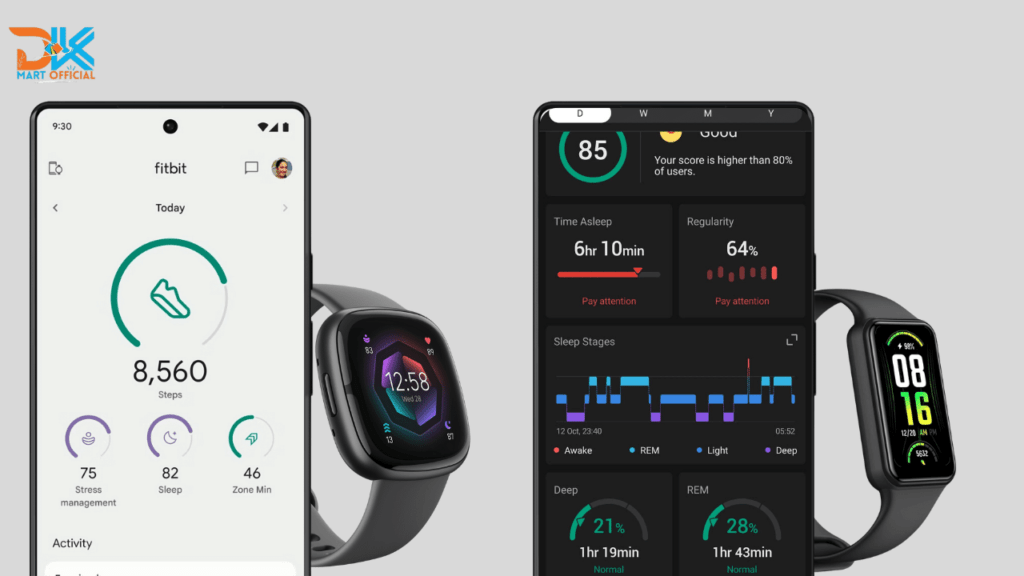
Fitbit vs Amazfit: Calorie Tracking
Fitbit vs Amazfit: Fitbit excels in providing consumers with detailed calorie tracking, using a mix of smart sensors and algorithms to precisely estimate energy expenditure. Fitbit devices use heart rate, activity intensity, and user profile information to measure calories burned throughout different activities. The brand’s devotion to precision extends to its app, which provides thorough breakdowns of calorie burn throughout the day. Fitbit’s emphasis on precision in calorie tracking guarantees that customers gain relevant insights into their energy expenditure, which helps them achieve their fitness and health goals.
Amazfit, powered by Huami’s technology breakthrough, provides intelligent calorie computation that considers many variables for a more precise estimate. Amazfit devices employ data from sensors such as heart rate monitors and accelerometers to determine the intensity of physical activity, giving consumers a more personalized understanding of calorie burn. The brand’s commitment to intelligent calorie tracking extends to its app, which allows customers to assess and measure their daily energy expenditure. Amazfit’s emphasis on precision in calorie estimate seeks to provide users with useful information so that they may make informed exercise and food decisions.
In the Fitbit vs Amazfit calorie tracking comparison, consumers can trust both brands to provide reliable estimates of energy expenditure during a variety of activities. Fitbit’s comprehensive approach and established reputation are consistent with its commitment to precision, whereas Amazfit’s intelligent computation adds a layer of adaptability to accommodate individual activity patterns. In terms of calorie tracking, the choice between Fitbit and Amazfit comes down to personal preferences for a comprehensive and historical picture vs a more dynamically adjusted approach.
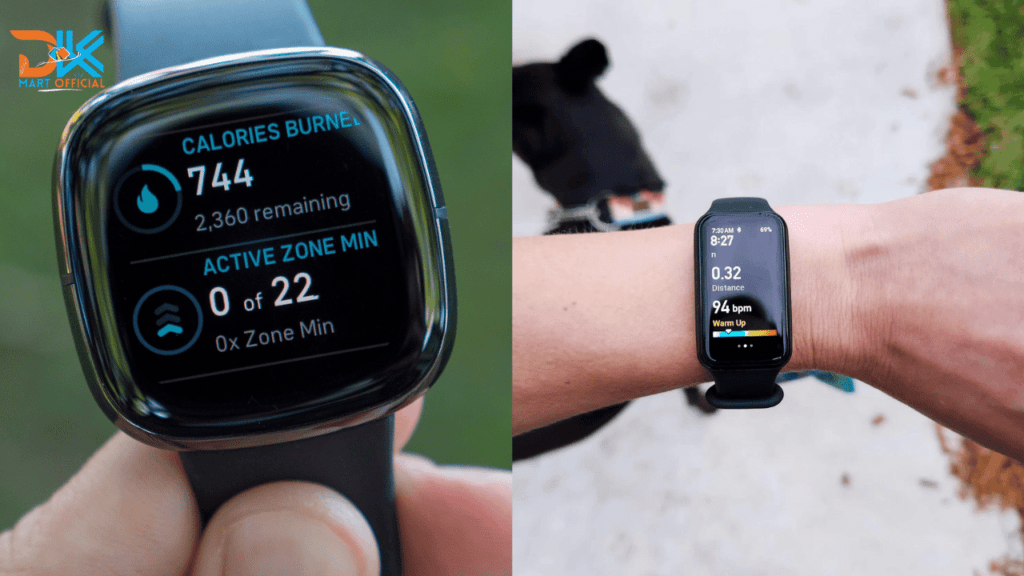
Fitbit vs Amazfit: Distance Tracking
Fitbit vs Amazfit: Fitbit devices are well-known for their accurate distance monitoring capabilities, which rely on modern technology like GPS and accelerometers. Fitbit delivers precise distance measures based on the user’s movement patterns and, where available, GPS data. The seamless integration of these technologies demonstrates the brand’s commitment to precision in distance tracking, providing consumers with confidence in the accuracy of their measured distances. Fitbit’s commitment to providing reliable measurements leads to a dependable fitness tracking experience for consumers who want to keep track of their distance traveled during various activities.
Amazfit, with Huami’s technology capabilities, improves distance monitoring by incorporating cutting-edge technologies into its gadgets. Amazfit trackers frequently include built-in GPS, which gives reliable position data and aids in distance monitoring during outdoor activities. The brand’s commitment to technological innovation extends to the use of accelerometers, which ensure accurate distance measuring across a wide range of physical activities. Amazfit’s technologically advanced distance monitoring aims to satisfy users who want not just precision but also the added benefits of GPS integration for a more complete understanding of their movement patterns.
In the Fitbit vs Amazfit distance tracking comparison, both brands provide reliable measures, with each using a combination of accelerometers and, in some cases, GPS for further precision. Fitbit’s known reliability is consistent with its goal to provide accurate distance measures, but Amazfit’s emphasis on technology advancements provides consumers with additional capabilities such as built-in GPS for a more comprehensive tracking experience. The decision between Fitbit and Amazfit for distance tracking is based on personal preferences for proven reliability versus technological innovation in distance monitoring.
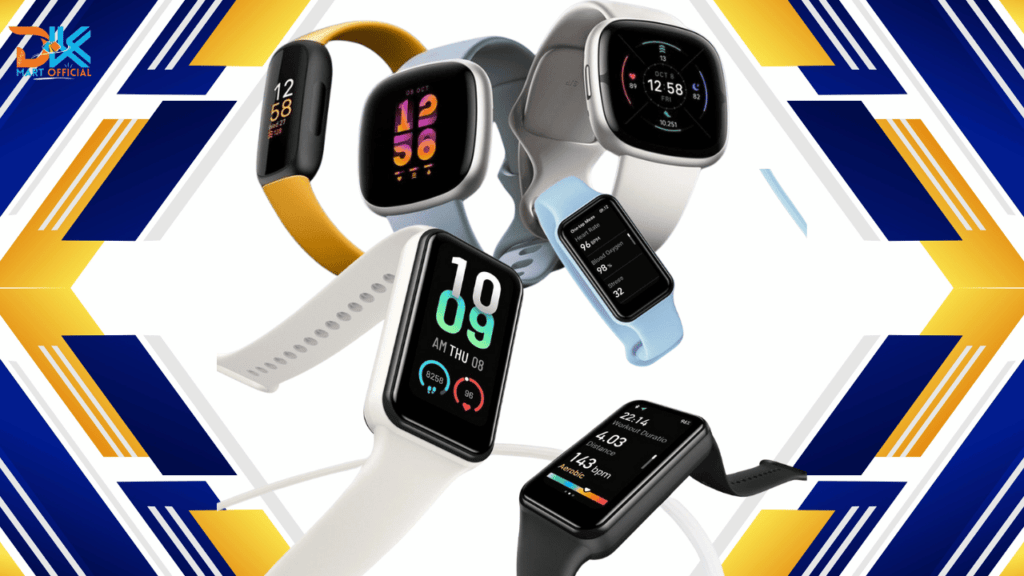
Here’s a Table Outlining The Pros and Cons of the Fitbit vs Amazfit:
| Pros | Cons |
| Fitbit | |
| Established Reputation: Fitbit is a well-established brand with a long history in the fitness tracking industry, known for reliability and precision. | Higher Price Point: Fitbit devices tend to be priced at a premium, making them relatively more expensive compared to some competitors. |
| Comprehensive Health Tracking: Fitbit devices offer accurate and comprehensive health tracking, including steps, heart rate, sleep, and specialized metrics like SpO2 and stress levels. | Limited Design Variety: While sleek, Fitbit’s design approach may be considered limited compared to brands offering a more diverse range of styles. |
| Mature App Ecosystem: Fitbit’s app ecosystem is mature and community-focused, offering a range of features, challenges, and a supportive community for users. | Limited Innovation: Some users argue that Fitbit’s innovation has been relatively conservative compared to emerging brands in the market. |
| Sleek Design: Fitbit is recognized for its sleek and minimalist design, providing users with comfortable and stylish fitness trackers. | |
| Excellent Battery Life: Fitbit devices are known for their prolonged battery life, often lasting a week or more on a single charge. | |
| Amazfit | |
| Affordable Innovation: Amazfit provides feature-rich fitness trackers at competitive prices, making advanced health tracking more accessible to a wider audience. | App Ecosystem Development: While improving, Amazfit’s app ecosystem is still developing and may not be as mature or feature-rich as some competitors. |
| Diverse Design Options: Amazfit offers a diverse range of design options, catering to different styles and preferences among users. | Brand Recognition: Amazfit may lack the same level of brand recognition and reputation as established players like Fitbit. |
| Technological Innovation: Backed by Huami’s technological expertise, Amazfit introduces advanced features like AMOLED displays, BioTracker for heart rate monitoring, and built-in GPS. | Potential Design Complexity: While diverse, the wide range of design options may introduce complexity for users who prefer a more straightforward selection. |
| Competitive Battery Life: Amazfit devices often boast competitive battery life, lasting several days on a single charge. | |
| Disruptive Pricing: Amazfit disrupts the market with its strategic pricing, providing users with high-tech features without the premium price tag. |
Frequently Asked Questions
[sp_easyaccordion id=”10145″]
Conclusion
In the fitness tracker comparison between Fitbit and Amazfit, users are given two attractive solutions that cater to a wide range of interests and priorities. Fitbit, a seasoned player with a long history, is notable for its minimalist design, smooth integration into daily life, and mature app ecosystem. Fitbit’s emphasis on precision, accuracy, and a broad array of health and fitness features distinguishes it as an excellent alternative for those looking for a premium, user-friendly experience. Fitbit’s products appeal to consumers who value established excellence and community-driven motivation via challenges and shared goals.
On the other hand, Amazfit disturbs the industry with a novel strategy that combines style and substance at a competitive price. Amazfit, powered by Huami’s technological capabilities, features a diverse design palette, sophisticated sensing technologies, and a burgeoning app ecosystem. Amazfit’s focus to price without sacrificing features makes it an appealing choice for budget-conscious individuals seeking superior fitness tracking capabilities. Amazfit’s role as a disruptor adds a dynamic element to the Fitbit vs Amazfit comparison, allowing users to choose between established reliability and innovation at a reasonable price. Finally, the decision comes down to personal preferences, whether it’s the attraction of Fitbit’s premium experience or the revolutionary pricing and technological breakthroughs presented by Amazfit.

